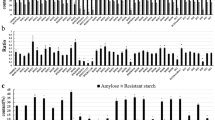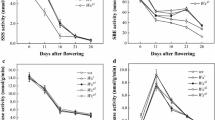Summary
Five mutant lines of rice with increased amylose content in starch granules were identified among floury endosperm mutants. The amylose contents of the mutants ranged from 29.4% to 35.4% and were about twice as high as that of the normal counterpart. Starch properties of the high amylose mutants were analyzed by column chromatography, X-ray diffractometry, photopastegraphy and scanning electron microscopy. The high amylose mutants produced longer unit chains of amylopectin than those of the normal counterpart as well as an increased amount of amylose. A X-ray diffractogram of starch in the mutant was characterized by a type B pattern, while that in the normal counterpart showed a type A pattern which is typical for starches of common cereals. The temperatures at the initiation of gelatinization of the mutants were much higher than that for the normal counterpart. The endosperm cells of the mutant were loosely packed with irregular round-shaped starch granules, whereas those of the normal counterpart were densely packed with polyhedral starch granules. Judging from the results obtained, it was concluded that starch properties of the high amylose mutants of rice were similar to those of the amylose-extender (ae) mutant of maize.
Similar content being viewed by others
References
Baba T, Arai Y, Ono T, Munakata A, Yamaguchi H, Itoh T (1982) Branching enzyme from amylomaize endosperms. Carbohydr Res 107:215–230
Banks W, Greenwood CT, Muir DD (1974) Studies on starches of high amylose content. Stärke 26:289–300
Boyer CD, Preiss J (1981) Evidence for independent genetic control of the multiple forms of maize endosperm branching enzymes and starch synthases. Plant Physiol 67:1141–1145
Boyer CD, Daniels RR, Shannon JC (1976) Abnormal starch granule formation inZea mays L. endosperms possesing theamylose-extender mutant. Crop Sci 16:298–301
Brown RP, Creech RG, Johnson LJ (1971) Genetic control of starch granule morphology and physical structure in developing maize endosperms. Crop Sci 11:297–302
Dubois M, Gilles KA, Hamilton JK, Pebers PA, Smith F (1956) Colorimetric method for determination of sugars and related substances. Anal Chem 28:350–356
Hilbert GE, MacMasters MM (1946) Pea starch, a starch of high amylose content. J Biol Chem 162:229–238
Hizukuri S, Takeda Y, Yasuda M, Suzuki A (1981) Multi-branched nature of amylose and the action of branching enzyme. Carbohydr Res 94:205–213
Ikawa Y, Glover DV, Sugimoto Y, Fuwa H (1978) Amylose percentage and distribution of unit chain-length of maize starches having a specific background. Carbohydr Res 61:211–216
Ikawa Y, Glover DV, Sugimoto Y, Fuwa H (1981) Some structural characteristics of starches of maize having a specific genetic background. Stärke 33:9–13
Inatsu O, Watanabe K, Maeda I, Ito K, Osanai S (1974) Studies to improve the quality of rice grown in Hokkaido. 1. Amylose contents of different rice starches (in Japanese with English summary). J Jpn Soc Starch Sci 21:115–119
Isono Y, Satoh H, Omura T (1978) Characteristics of low amylose mutants in rice induced by NMUA (in Japanese). Jpn J Breed 28 (Suppl 2):134–135
Iwata N, Omura T (1971) Linkage analysis by reciprocal translocation method in rice plant (Oryza sativa L.). 2. Linkage groupes corresponding to the Chromosome 5, 6, 8, 9, 10 and 11. Sci Bull Fac Agric Kyushu Univ 30:137–153
Kainuma K, Oda T, Suzuki S (1968a) Observation on the changes of starch granules during gelatinization by the novel photopastegraphy. 1. Design and use of a photopastegraph. Dempun Kogyo Gakkaishi 16:51–54
Kainuma K, Oda T, Fukino H, Tanida M, Suzuki S (1968b) Observation on the changes of starch granules during gelatinization by the novel photopastegraphy. 2. Analysis of the gelatinization range of starch granules by photopastegraphy. Dempun Kogyo Gakkaishi 16:54–60
Kramer HH, Pfahler PL, Whistler RL (1958) Gene interaction in maize affecting endosperm properties. Agron J 50:207–210
Okuno K (1976) A low amylose mutant of rice. Div Genet Natl Inst Agric Sci (Japan) Annu Rep 1:28–29
Satoh H, Omura T (1981) New endosperm mutations induced by chemical mutagens in rice,Oryza sativa L. Jpn J Breed 31:316–326
Vineyard ML, Bear RP (1952) Amylose content. Maize Genet Coop Newslett 26:5
Walker JT, Merritt NR (1969) Genetic control of abnormal starch granules and high amylose content in a mutant of Glacier barley. Nature 221:482–483
Yamada T, Taki M (1974) Fractionation of maize starch by Gel-chromatography. Stärke 28:374–377
Yamamoto K, Sawada S, Onogaki T (1973) Properties of rice starch prepared by alkali method with various conditions (in Japanese with English summary). J Jpn Soc Starch Sci 20:99–104
Author information
Authors and Affiliations
Additional information
Communicated by P. L. Pfahler
Rights and permissions
About this article
Cite this article
Yano, M., Okuno, K., Kawakami, J. et al. High amylose mutants of rice,Oryza sativa L.. Theoret. Appl. Genetics 69, 253–257 (1985). https://doi.org/10.1007/BF00662436
Received:
Accepted:
Issue Date:
DOI: https://doi.org/10.1007/BF00662436




